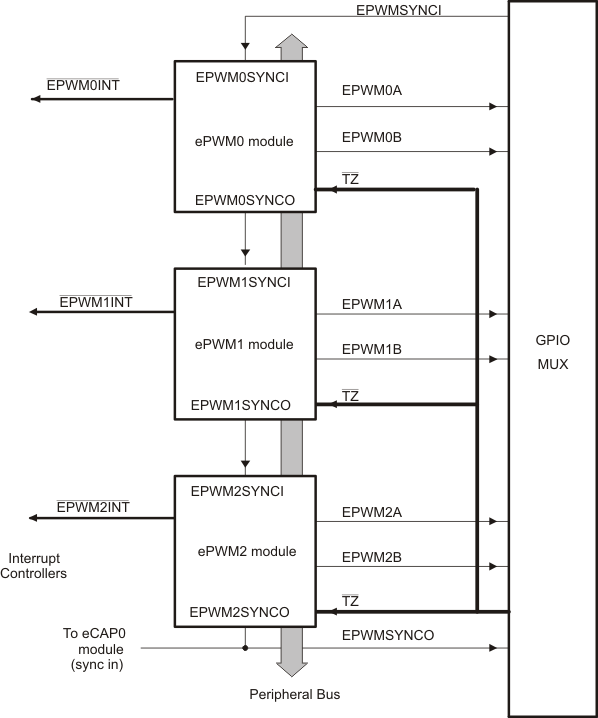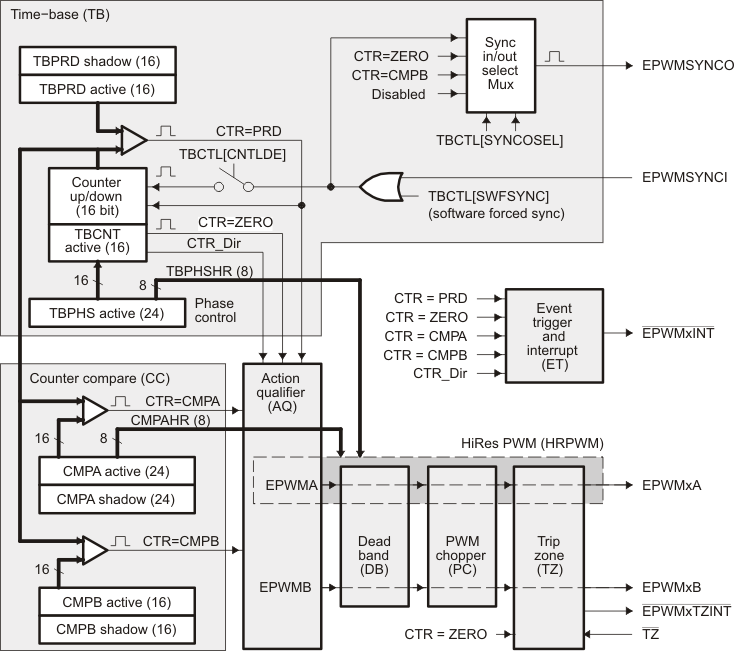SPRS565D April 2009 – June 2014 TMS320C6743
PRODUCTION DATA.
- 1TMS320C6743 Fixed- and Floating-Point Digital Signal Processor
- 2Revision History
-
3Device Overview
- 3.1 Device Characteristics
- 3.2 Device Compatibility
- 3.3 DSP Subsystem
- 3.4 Memory Map Summary
- 3.5 Pin Assignments
- 3.6
Terminal Functions
- 3.6.1 Device Reset and JTAG
- 3.6.2 High-Frequency Oscillator and PLL
- 3.6.3 External Memory Interface A (ASYNC)
- 3.6.4 External Memory Interface B (SDRAM only)
- 3.6.5 Serial Peripheral Interface Modules (SPI0)
- 3.6.6 Enhanced Capture/Auxiliary PWM Modules (eCAP0, eCAP1, eCAP2)
- 3.6.7 Enhanced Pulse Width Modulators (eHRPWM0, eHRPWM1, eHRPWM2)
- 3.6.8 Enhanced Quadrature Encoder Pulse Module (eQEP)
- 3.6.9 Boot
- 3.6.10 Universal Asynchronous Receiver/Transmitters (UART0, UART2)
- 3.6.11 Inter-Integrated Circuit Modules (I2C0, I2C1)
- 3.6.12 Timers
- 3.6.13 Multichannel Audio Serial Ports (McASP0, McASP1)
- 3.6.14 Ethernet Media Access Controller (EMAC)
- 3.6.15 Multimedia Card/Secure Digital (MMC/SD)
- 3.6.16 General-Purpose IO Only Terminal Functions
- 3.6.17 Reserved and No Connect Terminal Functions
- 3.6.18 Supply and Ground Terminal Functions
- 4Device Configuration
-
5Device Operating Conditions
- 5.1 Absolute Maximum Ratings Over Operating Junction Temperature Range (Unless Otherwise Noted)
- 5.2 Handling Ratings
- 5.3 Recommended Operating Conditions
- 5.4 Notes on Recommended Power-On Hours (POH)
- 5.5 Electrical Characteristics Over Recommended Ranges of Supply Voltage and Operating Junction Temperature (Unless Otherwise Noted)
-
6Peripheral Information and Electrical Specifications
- 6.1 Parameter Information
- 6.2 Recommended Clock and Control Signal Transition Behavior
- 6.3 Power Supplies
- 6.4 Reset
- 6.5 Crystal Oscillator or External Clock Input
- 6.6 Clock PLLs
- 6.7 DSP Interrupts
- 6.8 General-Purpose Input/Output (GPIO)
- 6.9 EDMA
- 6.10 External Memory Interface A (EMIFA)
- 6.11 External Memory Interface B (EMIFB)
- 6.12 Memory Protection Units
- 6.13 MMC / SD / SDIO (MMCSD)
- 6.14 Ethernet Media Access Controller (EMAC)
- 6.15 Management Data Input/Output (MDIO)
- 6.16 Multichannel Audio Serial Ports (McASP0, McASP1)
- 6.17
Serial Peripheral Interface Ports (SPI0)
- 6.17.1 SPI Peripheral Registers Description(s)
- 6.17.2
SPI Electrical Data/Timing
- 6.17.2.1
Serial Peripheral Interface (SPI) Timing
- Table 6-49 General Timing Requirements for SPI0 Master Modes
- Table 6-50 General Timing Requirements for SPI0 Slave Modes
- Table 6-51 Additional SPI0 Master Timings, 4-Pin Enable Option
- Table 6-52 Additional SPI0 Master Timings, 4-Pin Chip Select Option
- Table 6-53 Additional SPI0 Master Timings, 5-Pin Option
- Table 6-54 Additional SPI0 Slave Timings, 4-Pin Enable Option
- Table 6-55 Additional SPI0 Slave Timings, 4-Pin Chip Select Option
- Table 6-56 Additional SPI0 Slave Timings, 5-Pin Option
- 6.17.2.1
Serial Peripheral Interface (SPI) Timing
- 6.18 Enhanced Capture (eCAP) Peripheral
- 6.19 Enhanced Quadrature Encoder (eQEP) Peripheral
- 6.20 Enhanced Pulse Width Modulator (eHRPWM) Modules
- 6.21 Timers
- 6.22 Inter-Integrated Circuit Serial Ports (I2C0, I2C1)
- 6.23 Universal Asynchronous Receiver/Transmitter (UART)
- 6.24 Power and Sleep Controller (PSC)
- 6.25 Programmable Real-Time Unit Subsystem (PRUSS)
- 6.26 Emulation Logic
- 6.27 IEEE 1149.1 JTAG
- 7Device and Documentation Support
- 8Mechanical Packaging and Orderable Information
Package Options
Refer to the PDF data sheet for device specific package drawings
Mechanical Data (Package|Pins)
- ZKB|256
- PTP|176
Thermal pad, mechanical data (Package|Pins)
- PTP|176
Orderable Information
6.20 Enhanced Pulse Width Modulator (eHRPWM) Modules
The device contains up to three enhanced PWM Modules (eHRPWM). Figure 6-39 shows a block diagram of multiple eHRPWM modules. Figure 4-4 shows the signal interconnections with the eHRPWM. See the TMS320C674x/OMAP-L1x Processor Peripherals Overview Reference Guide (SPRUFK9) for more details.
 Figure 6-39 Multiple PWM Modules in a C6743 System
Figure 6-39 Multiple PWM Modules in a C6743 System  Figure 6-40 eHRPWM Sub-Modules Showing Critical Internal Signal Interconnections
Figure 6-40 eHRPWM Sub-Modules Showing Critical Internal Signal Interconnections Table 6-63 eHRPWM Module Control and Status Registers Grouped by Submodule
| eHRPWM1
BYTE ADDRESS |
eHRPWM2
BYTE ADDRESS |
eHRPWM3
BYTE ADDRESS |
REGISTER
NAME |
SIZE (×16) | SHADOW | REGISTER DESCRIPTION |
|---|---|---|---|---|---|---|
| Time-Base Submodule Registers | ||||||
| 0x01F0 0000 | 0x01F0 2000 | 0x01F0 4000 | TBCTL | 1 | No | Time-Base Control Register |
| 0x01F0 0002 | 0x01F0 2002 | 0x01F0 4002 | TBSTS | 1 | No | Time-Base Status Register |
| 0x01F0 0004 | 0x01F0 2004 | 0x01F0 4004 | TBPHSHR | 1 | No | Extension for HRPWM Phase Register (1) |
| 0x01F0 0006 | 0x01F0 2006 | 0x01F0 4006 | TBPHS | 1 | No | Time-Base Phase Register |
| 0x01F0 0008 | 0x01F0 2008 | 0x01F0 4008 | TBCNT | 1 | No | Time-Base Counter Register |
| 0x01F0 000A | 0x01F0 200A | 0x01F0 400A | TBPRD | 1 | Yes | Time-Base Period Register |
| Counter-Compare Submodule Registers | ||||||
| 0x01F0 000E | 0x01F0 200E | 0x01F0 400E | CMPCTL | 1 | No | Counter-Compare Control Register |
| 0x01F0 0010 | 0x01F0 2010 | 0x01F0 4010 | CMPAHR | 1 | No | Extension for HRPWM Counter-Compare A Register (1) |
| 0x01F0 0012 | 0x01F0 2012 | 0x01F0 4012 | CMPA | 1 | Yes | Counter-Compare A Register |
| 0x01F0 0014 | 0x01F0 2014 | 0x01F0 4014 | CMPB | 1 | Yes | Counter-Compare B Register |
| Action-Qualifier Submodule Registers | ||||||
| 0x01F0 0016 | 0x01F0 2016 | 0x01F0 4016 | AQCTLA | 1 | No | Action-Qualifier Control Register for Output A (eHRPWMxA) |
| 0x01F0 0018 | 0x01F0 2018 | 0x01F0 4018 | AQCTLB | 1 | No | Action-Qualifier Control Register for Output B (eHRPWMxB) |
| 0x01F0 001A | 0x01F0 201A | 0x01F0 401A | AQSFRC | 1 | No | Action-Qualifier Software Force Register |
| 0x01F0 001C | 0x01F0 201C | 0x01F0 401C | AQCSFRC | 1 | Yes | Action-Qualifier Continuous S/W Force Register Set |
| Dead-Band Generator Submodule Registers | ||||||
| 0x01F0 001E | 0x01F0 201E | 0x01F0 401E | DBCTL | 1 | No | Dead-Band Generator Control Register |
| 0x01F0 0020 | 0x01F0 2020 | 0x01F0 4020 | DBRED | 1 | No | Dead-Band Generator Rising Edge Delay Count Register |
| 0x01F0 0022 | 0x01F0 2022 | 0x01F0 4022 | DBFED | 1 | No | Dead-Band Generator Falling Edge Delay Count Register |
| PWM-Chopper Submodule Registers | ||||||
| 0x01F0 003C | 0x01F0 203C | 0x01F0 403C | PCCTL | 1 | No | PWM-Chopper Control Register |
| Trip-Zone Submodule Registers | ||||||
| 0x01F0 0024 | 0x01F0 2024 | 0x01F0 4024 | TZSEL | 1 | No | Trip-Zone Select Register |
| 0x01F0 0028 | 0x01F0 2028 | 0x01F0 4028 | TZCTL | 1 | No | Trip-Zone Control Register |
| 0x01F0 002A | 0x01F0 202A | 0x01F0 402A | TZEINT | 1 | No | Trip-Zone Enable Interrupt Register |
| 0x01F0 002C | 0x01F0 202C | 0x01F0 402C | TZFLG | 1 | No | Trip-Zone Flag Register |
| 0x01F0 002E | 0x01F0 202E | 0x01F0 402E | TZCLR | 1 | No | Trip-Zone Clear Register |
| 0x01F0 0030 | 0x01F0 2030 | 0x01F0 4030 | TZFRC | 1 | No | Trip-Zone Force Register |
| Event-Trigger Submodule Registers | ||||||
| 0x01F0 0032 | 0x01F0 2032 | 0x01F0 4032 | ETSEL | 1 | No | Event-Trigger Selection Register |
| 0x01F0 0034 | 0x01F0 2034 | 0x01F0 4034 | ETPS | 1 | No | Event-Trigger Pre-Scale Register |
| 0x01F0 0036 | 0x01F0 2036 | 0x01F0 4036 | ETFLG | 1 | No | Event-Trigger Flag Register |
| 0x01F0 0038 | 0x01F0 2038 | 0x01F0 4038 | ETCLR | 1 | No | Event-Trigger Clear Register |
| 0x01F0 003A | 0x01F0 203A | 0x01F0 403A | ETFRC | 1 | No | Event-Trigger Force Register |
| High-Resolution PWM (HRPWM) Submodule Registers | ||||||
| 0x01F0 1040 | 0x01F0 3040 | 0x01F0 5040 | HRCNFG | 1 | No | HRPWM Configuration Register (1) |
(1) These registers are only available on eHRPWM instances that include the high-resolution PWM (HRPWM) extension; otherwise, these locations are reserved.